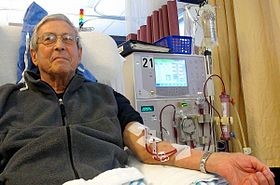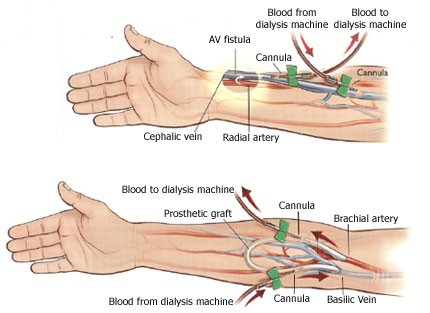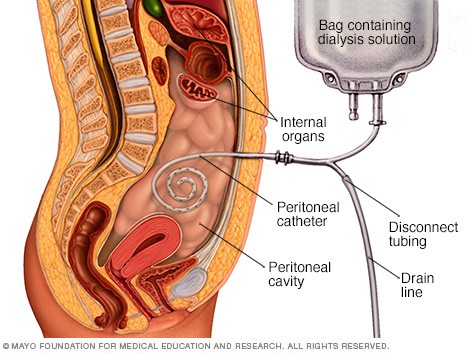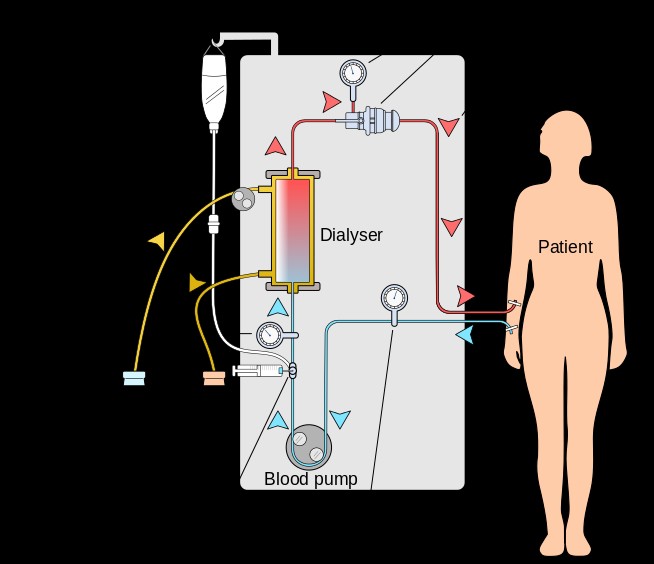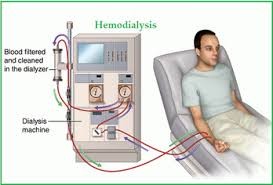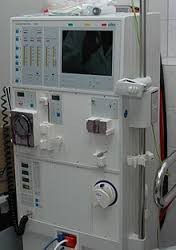Dialysis
Haemodialysis
Definition
o Hemodialysis is a process to remove fluid and waste products from the body and blood when the kidneys cannot do so.
o May also be used for
oedema
hepatic coma,
hyperkalemia,
hypercalcemia,
hypertension
uremia
o Dialyzer - serves as a synthetic semipermeable membrane replacing renal glomeruli and tubules.
o Treatement for 3 - 4 hours 3 - 4 times a week
o Or - short daily haemodialysis
Principle of Dialysis
o Dialysis works on the principle of diffusion of solutes across a semipermeable membrane - osmosis
o Smaller solutes pass through the membrane.
o The concentrations of undesired solutes (for example potassium, urea, and phosphorus) are high in the blood, but low or absent in the dialysis solution.
o The dialysis solution is isotonic for sodium and chloride.
o For bicarbonate, dialysis solution level is set at a slightly higher level than in normal blood, to encourage diffusion of bicarbonate into the blood, to neutralise the acidosis that is often present in these patients.
Indications
- volume overload
- electrolyte imbalance
- uremic symptons
Contraindications/disadvantages
- Hemodynamic instability
- vascular access problems
- hepatitis
- muscle cramping
- bleeding tendencies due to anticoagulant used
Types of vascular access
- Temporary double or single lumen catheters
- AV fistulas
- grafts (Gortex)
- shunts (Scribner)
Vascular Access
o The rate of flow should be 200 to 800 ml / mt.
o Subclavian, internal jugular, and femoral catheters
o Double or multilumen catheters
o Fistula - AV fistula - created by surgery - between the cephalic vein and the radial artery - near the wrist - fistula takes 4 - 6 weeks to mature
Graft
o An arteriovenous graft created - synthetic graft made of PTFE = polytetrafluoroethylene
o Fore arm, upper arm, upper thigh
o For patients who don't have suitable vessels
o Complications - infection, thrombosis
Complications and problems during dialysis
o Disturbances of lipid metabolism
o Fluid overload
o Heart failure, CAD, anginal pain
o Stroke
o Anemia and fatigue
o Gastric ulcers - due to physiological stress
o Renal osteodystrophy that produces bone pain and fractures
o Malnutrition
o Infection
o Neuropathy and pruritus
o Hypotension
o Painful muscle cramping
o Exsanguination accidental
o Dysrhythmias
o Air embolism
o Chest pain
Types of continuous renal relacement therapy
o Cotinuous arteriovenous haemofiltration - for fluid overload
o Continuous arteriovenous haemodialysis - faster clearance of urea
o Continuous venovenous haemofiltration - double-lumen catheter - acute renal failure
o Continuous venovenous haemodialysis
Peritoneal Dialysis
is dialysis using the peritoneum as the dialyzer - the semipermeable membrane
Indications :
o Those who are unwilling to undergo haemodialysis
o Diabetes mellitus
o Cardiovascular disease
o Elderly patients
o Risk of heparin
o Severe hypertension
o Heart failure
o Pulmonary oedema
Peritoneal - approaches
o Acute intermittent peritoneal dialysis
o Continuous ambulatory peritoneal dialysis (CAPD)
o Continuous cyclic peritoneal dialysis (CCPD)
Underlying principles
o Peritoneum - a serous membrane - used as the semipermeable membrane - 22000 cm2
o Sterile dialysate introduced into the peritoneal cavity at intervals through an abdominal catheter at intervals
o Urea and creatinine and other metabolic end-products normally excreted by the kidneys are cleared from the blood by diffusion and osmosis
Procedure
o Explain
o Record baseline vital signs, weight, electrolytes level
o Empty bladder and bowel to avoid injury
o Prophylactic antibiotics
Preparing the equipment
o Assemble the equipment
o Decide concentration of the dialysate
o Antibiotics and heparin added
o Aseptic precautions
o Warm up the solution
o Avoid air in the tubing
Inserting the catheter
o At OT - preferable
o A rigid stylet catheter for acute dialysis only
o Skin painted with antiseptics
o Local anaesthesia
o Stab wound 3 - 5 cm below the umbilicus
o Trocar inserted, catheter inserted, trocar removed and catheter is secured to the abdominal wall by a purse string suture.
o Catheter - silicone - radio-opaque
Performing the exchange
o A series of exchanges or cycles - infusion, dwell and drainage
o Infused by gravity
o 2 litres over 5 - 10 mts
o Dwell time varies - 1 to 3 hours
Complications of peritoneal dialysis
o Peritonitis
o Leakage
o Bleeding
Long term complications
o Hypertriglyceridemia
o Abdominal hernias
o Low back pain
o Clots in the peritoneal catheter
o constipation
Types of Peritoneal dialysis
o Acute Intermittent Peritoneal Dialysis
o Continuous Ambulatory Peritoneal Dialysis
o Continuous Cyclic Peritoneal Dialysis
Nursing Management
o Protect the vascular access
The limb is not used to measure BP
No blood specimens from that limb
Avoid tight dressings, jewellery
The bruit or thrill monitored to detect block
o Meet psychosocial needs
o Promote home and community based care
o Teach patients self-care
o Teach patients about haemodialysis
o Educate about continuing care
o Take precautions during intravenous therapy - strict volume control - use volumetric infusion pumps
o Monitor symptoms of uremia
o Detect cardiac and respiratory complications - fluid overload - heart failure - pulmonary oedema - pericarditis - pericardial effusion
o Control electrolyte levels and diet
o Manage discomfort and pain
o Monitor blood pressure
o Prevent infection
o Care for catheter site
o Administer medications
o Provide psychological support


